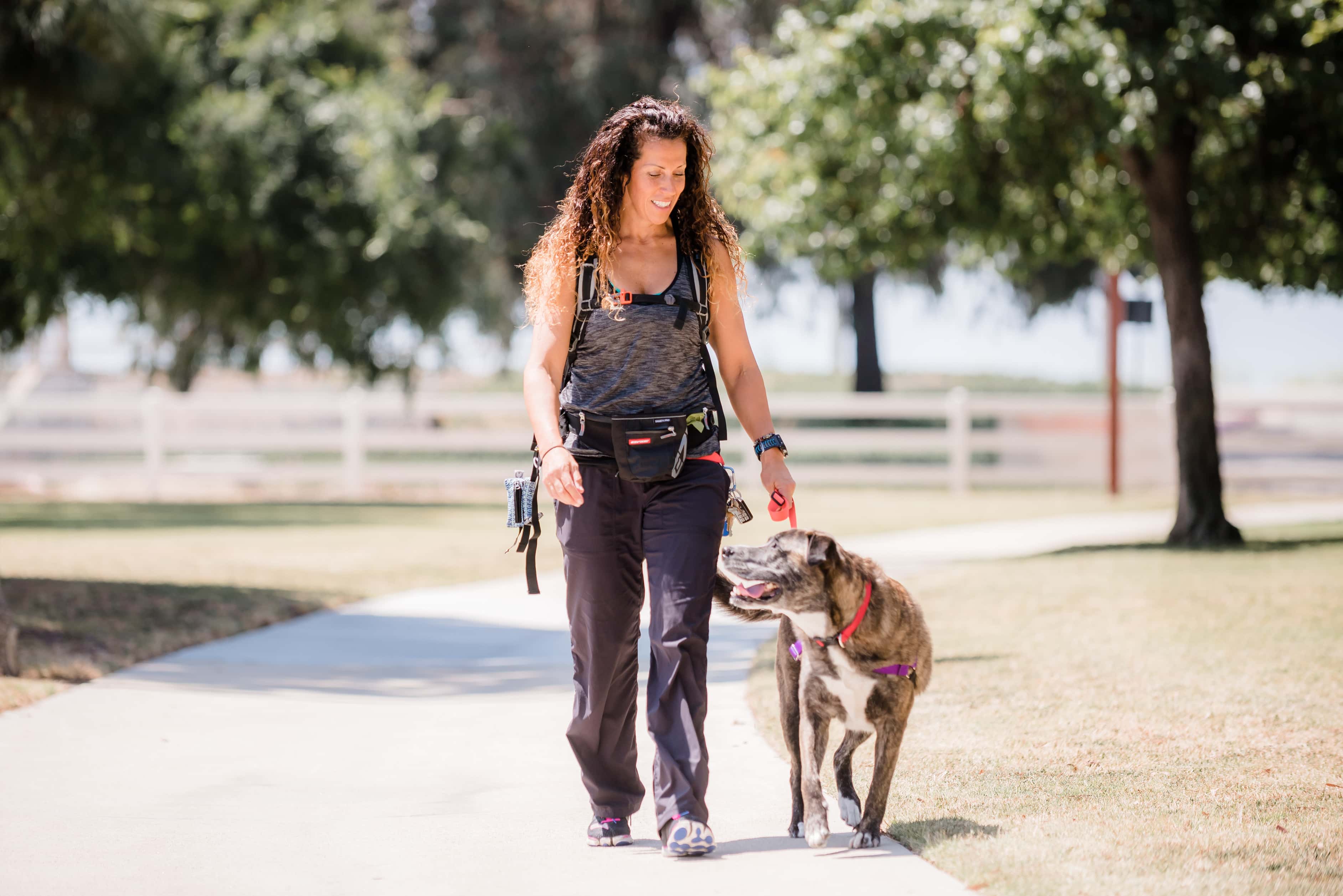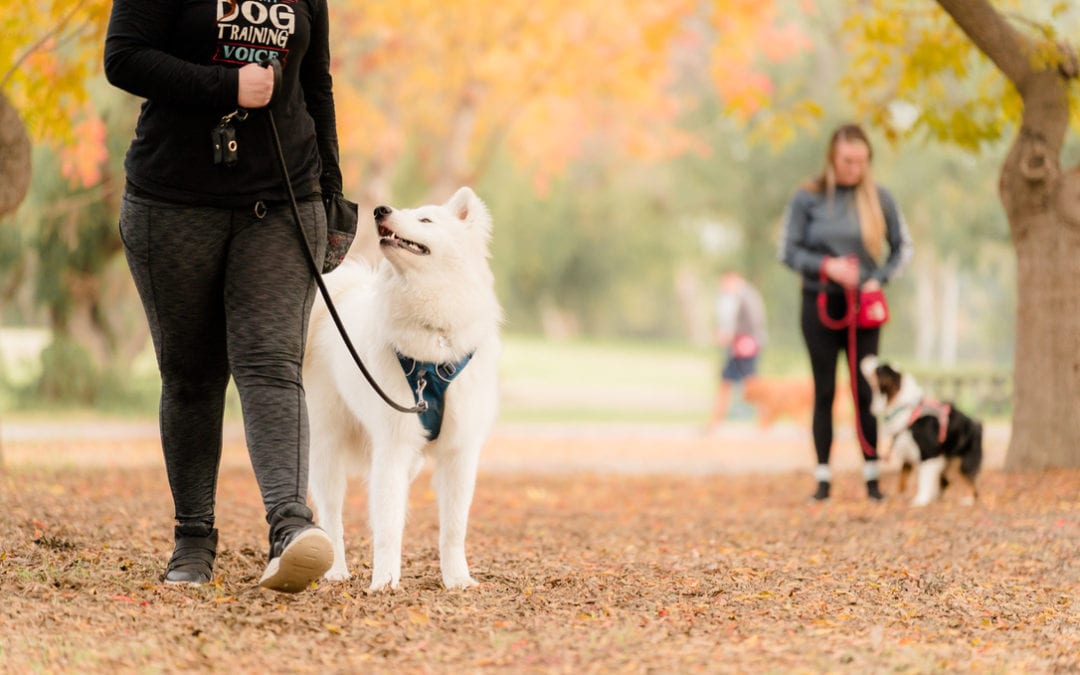
Does your dog pull like crazy whenever you leave the house?
Do you find that your walks have become stressful rather than the joyful experience you expected they’d be?
Teaching your dog to walk calmly beside you is one of the most desired behaviours when it comes to dog training. When your dog can walk calmly on their leash without pulling or lunging, your walks become much more enjoyable.
A world of opportunity opens up once you master loose leash walking. You suddenly feel much more confident to explore new places and have amazing experiences together.
It will take time to master, but there are a few key things that will help you and your dog succeed.
Mastering Loose Leash Walking
The first step to set your dog up for success is to choose a location that won’t be overwhelming.
Whenever we are teaching a new skill or behaviour, we need to start in an environment that is quiet and without distractions so that your dog can focus on learning and mastering their new skill.
Start your training at home in your yard or on a quiet street before progressing to more distracting environments.
Teaching the Walking Position
The first thing we need to teach your dog is the position you would like them to walk in. It’s best to start this training WITHOUT a leash!
While our ultimate goal is to teach your dog to walk nicely on a loose leash, the leash can be a big distraction for some dogs. Your dog may find the movement of the leash exciting, or the movement may even startle your dog and make them feel nervous.
So, in the spirit of setting your dog up for success, we begin training without a leash.
Grab some high value, delicious treats and show your dog the goodies!
Reward your dog at your side with your tasty treats, and then start walking.
As your dog catches up to you, mark when they are close to you and reward with a treat by your side. (Be sure to offer the reward low enough that your dog can take it with all four paws on the ground.)
If you consistently reward in the same place, your dog will be more likely to seek out this location as you walk together.
Practice moving away and rewarding your dog whenever they choose to come close to your side.
As your dog gets good at this, you can start to walk further with your dog beside you before rewarding.
Working on teaching your dog to walk beside you without the leash will really speed up how quickly they can master the art of walking nicely on their leash.
Once your dog has mastered the skill of walking at your side without a leash, you can then introduce the leash and follow the training steps again in a quiet environment.
Progress to Loose Leash Walking in New Environments
As your dog becomes more skilled at walking on a loose leash, you will want to take your new skills on the road.
Choose the places you progress your training to carefully. Remember, we want your dog to succeed, so take it slowly.
When you arrive at your training location, give your dog some time to relax into their surroundings before you start training.
When you first arrive, go on a sniffari together. A sniffari is a walk which is led by your dog’s nose! This will give your dog a chance to investigate the environment, relax, and acclimatize.
This helps to settle excitable dogs and also boosts confidence in dogs who are more reserved.
When you see your dog’s body language softening and their movements become calmer, you can see if your dog is ready to move on to stage two; focusing on you.
At this point, you are going to try the loose-leash training you have mastered at home in quiet spaces.
Teaching your Dog to Check-in while on the Move
One of the easiest ways to improve your dog’s walking skills and general focus when out and about is to reward them for checking in.
This means that every time your dog looks at you voluntarily, you’re going to mark and reward them with something they love.
When you’re out walking, and your dog is voluntarily checking in with you regularly, you’ll become more connected to each other’s movements. This really helps when it comes to changing direction on your walk, or stopping at the curbside. Your dog will become more aware of your body movements and less focused on everything else around them.
The goal is to have your dog periodically look at you, but shouldn’t be about building constant eye contact. Just a check-in.
After you’ve practised in multiple locations, you can start to fade out the need to reward for every check-in and instead verbally praise your dog as you continue to walk together.
Figure Eight Walk
Once you’ve taught your dog the position you would like them to walk in, you can start to develop their skills further.
Walking in figure eights can help your dog to practice turning with you whilst remaining on a loose leash throughout. As you walk, you reward your dog by your side when the leash is slack.
Start by setting out two objects to walk around in a quiet area, like your garden or neighborhood streets.
By walking in figure eights, you will be able to practice turning away from and towards your dog. If they turn with you, mark and reward them by your side.
If your dog starts to pull forward or back, stop moving and encourage them back to your side before continuing.
When your dog is getting good at this, you can practice using obstacles you find on your walks, such as planters, trees or even bike racks.
Not only are you building excellent walking skills, but you’re teaching your dog to ignore the objects you’re moving around and building up their confidence in novel situations.
Changing Direction to Build Better Focus
One of the ways you can encourage your dog to pay closer attention to you is by changing direction to mix things up a bit, create interest and excitement by being unpredictable and fun.
This will help not only build great focus on the leash, but it’s perfect for laying the foundations for a brilliant recall too.
When you’re walking along with your dog, try mixing it up a little bit. Suddenly change your orientation and dash in a different direction.
As soon as your dog sees that you’re not beside them anymore, they’ll look around and come rushing towards you. Capture that magic and reward them when they get close.
Start by practicing this on a regular length leash, and then progress to a longline. Once your dog has a reliable recall, you can continue practising off-leash.
Check out our recall blog for more tips on how to teach your dog a superb recall.
Keep your dog guessing and ramp up the fun. How quickly can they keep up with you?
After teaching your dog in a quiet location, be sure to also practice in various situations with increased distractions. This will help ensure your dog is ready to use the new skill, no matter where you are.
Practice Turns on Your Walk
Whenever you’re walking your dog, they’re learning the little signals you consistently do that help them predict what will happen next. The more aware you are of your body movements, the more you can consciously develop the communication between you and your dog.
This enables you to walk in harmony together. In time, you will be able to easily navigate turns and obstacles without the need for verbal cues.
In this exercise, you’re going to practice turns. Turning away from your dog is easiest, but you’ll also want to practice turns towards you too.
As always, find yourself a quiet location to practice and start by moving in a large square with your dog on the outside.
Before each turn, slow down and be aware of how you move your body.
You might step into the turn with the corresponding foot to the direction you’re turning. Perhaps you point your upper body in the direction you want to move, or you might signal with your hands the direction you intend to turn.
Whatever you choose to do, make sure it is consistent, and your dog will start to respond to your subtle body movements and move alongside you with ease.
When your dog is doing well, practice moving in the opposite direction so that you turn towards your dog.
Another setup you can practice is walking in a T shaped route. Sometimes you will turn left, sometimes right, and sometimes in the opposite direction.
Practicing these turns in a quiet environment before taking your dog out to more distracting locations will help your dog to succeed, making walks together much more enjoyable.
Escaping Distractions that make Loose Leash Walking Tricky
When you’re walking your dog, there’ll be times that you become aware of a scenario unfolding that may make it difficult for your dog to remain focused on you.
Be aware of your environment and try to spot things that your dog might get overexcited or worried by before you come face to face with them.
This allows you to take preventative action before things escalate.
You can change your direction, increase distance, cross the street or get your dog to sit and focus on you until things pass.
Use Treat Magnet when you need to Escape
Sometimes situations arise when you cannot move far enough away for your dog to relax. For example, you may have found yourself in a suddenly busy situation with no feasible escape routes.
This means you have to pass something you know your dog is not prepared for. In these situations, you can use a treat magnet to keep your dog’s attention as you quickly move past the distraction.
To do this, you will need a high-value reward that your dog loves.
Hold the treat between your fingers and thumb at nose height for your dog. Lure your dog to walk closely beside you. Let him lick and chew pieces off of the treat as you move. Move quickly past the distractions, and when you’re safely past, you can return to walking normally together.
Setting up for Success
Setting your dog up to succeed is essential if you want to enjoy relaxing walks together throughout your life. Remember, things can change quickly, so always pay attention to the world around you and be ready to take action when needed.
If you want to make real progress with your loose leash training, then bookmark this page and slowly progress through the different trainings at your dog’s pace.
Need more help? Canine Learning Academy offers all day school and private in home training. Space is very limited for our dog training school, call now for more information:
877 428-8285

